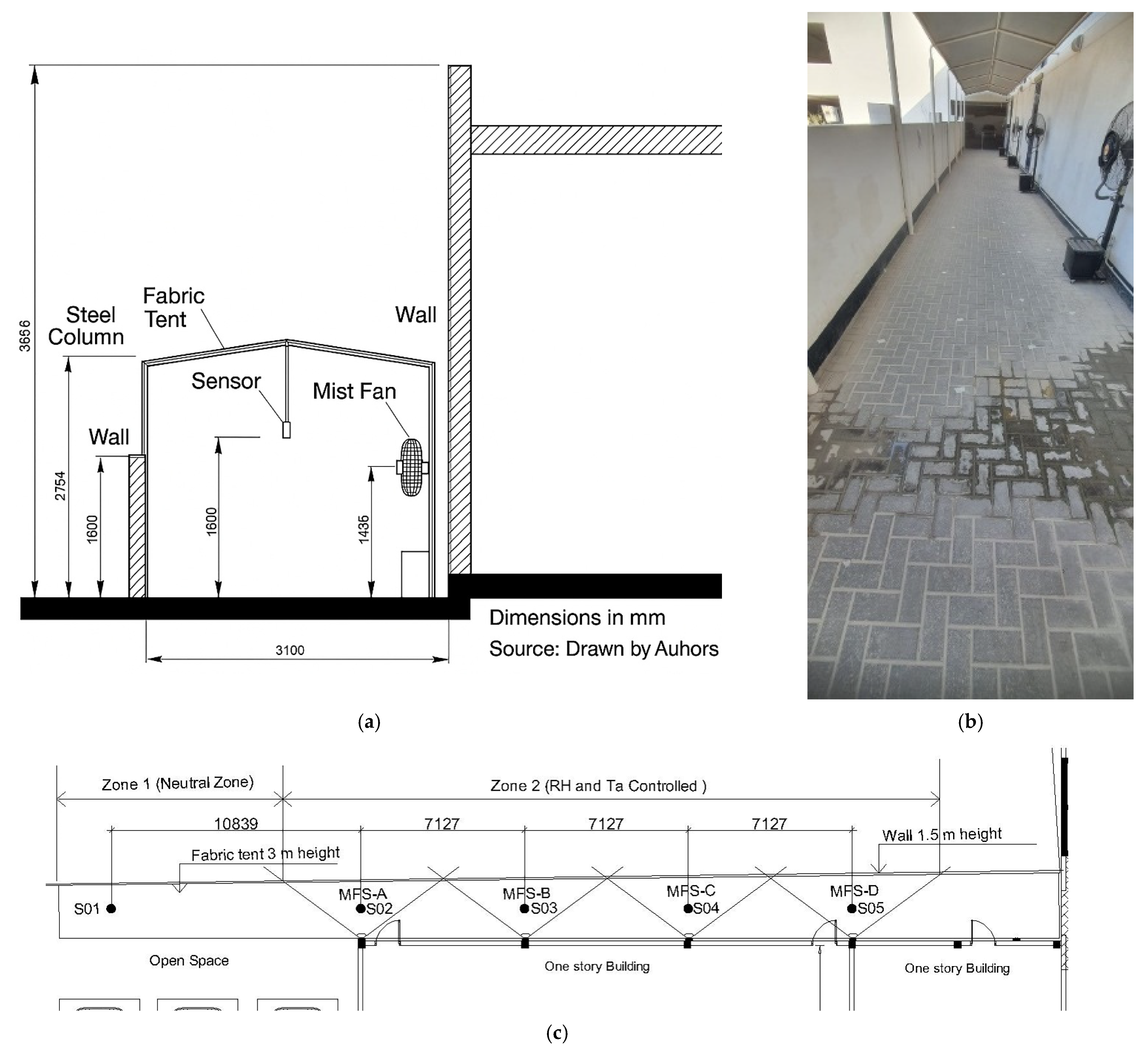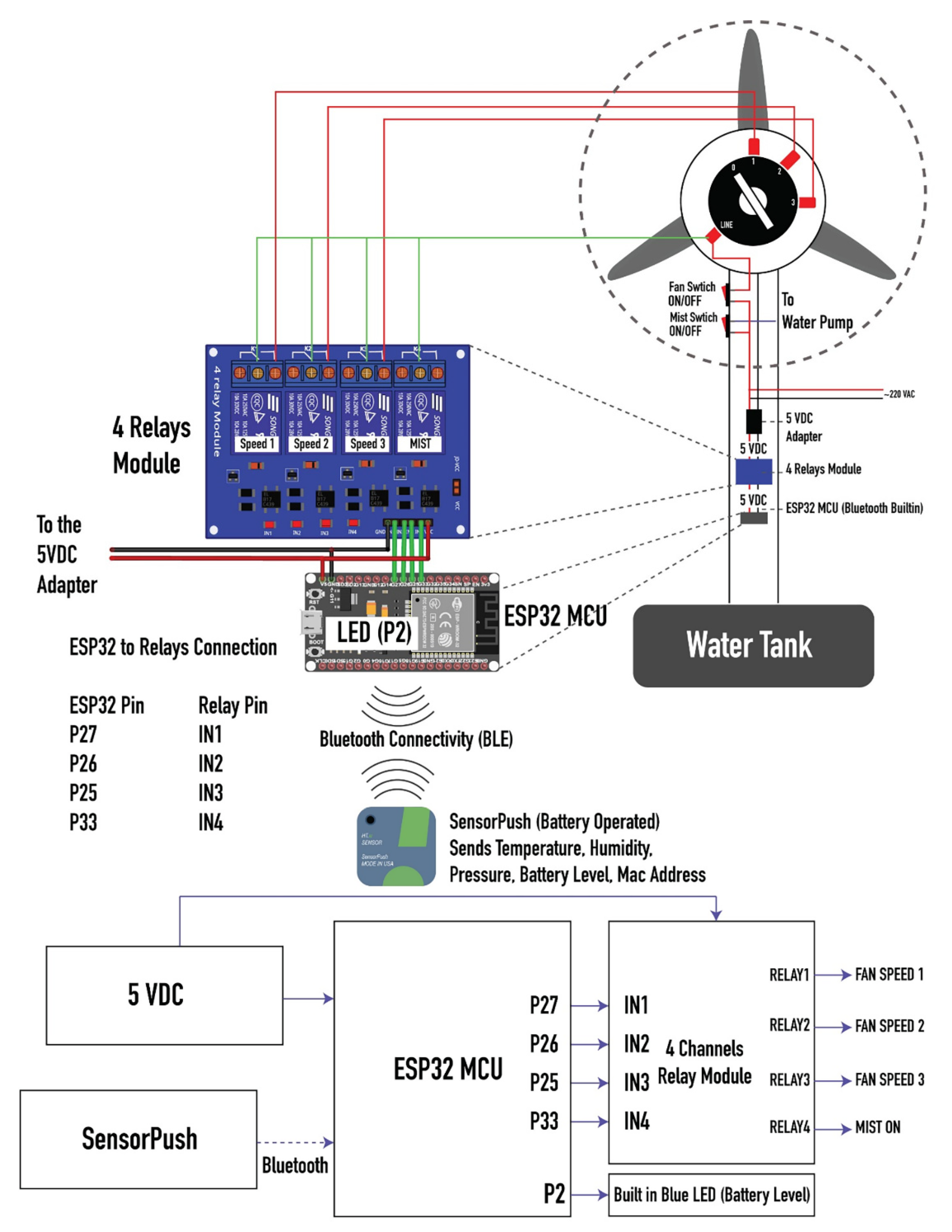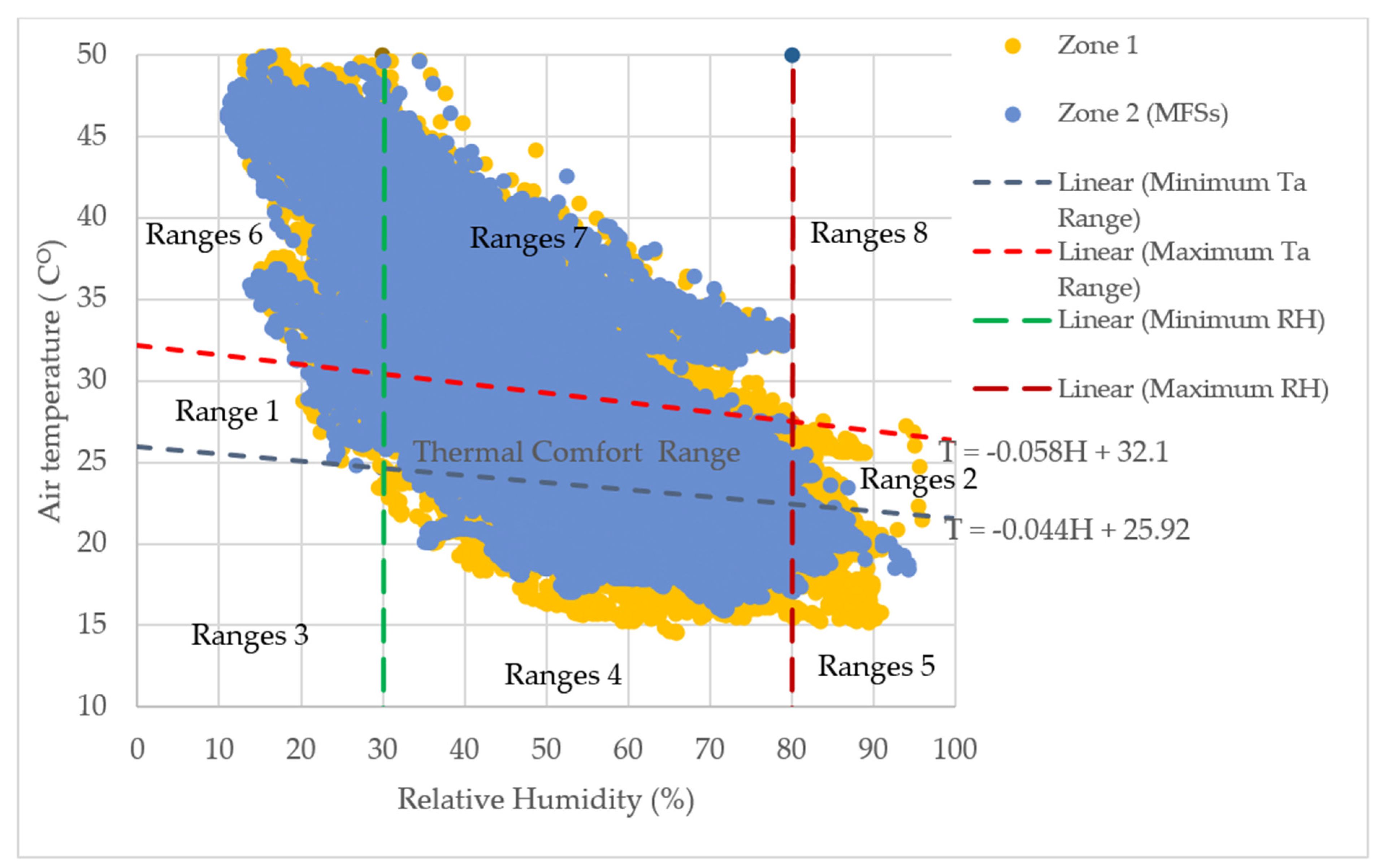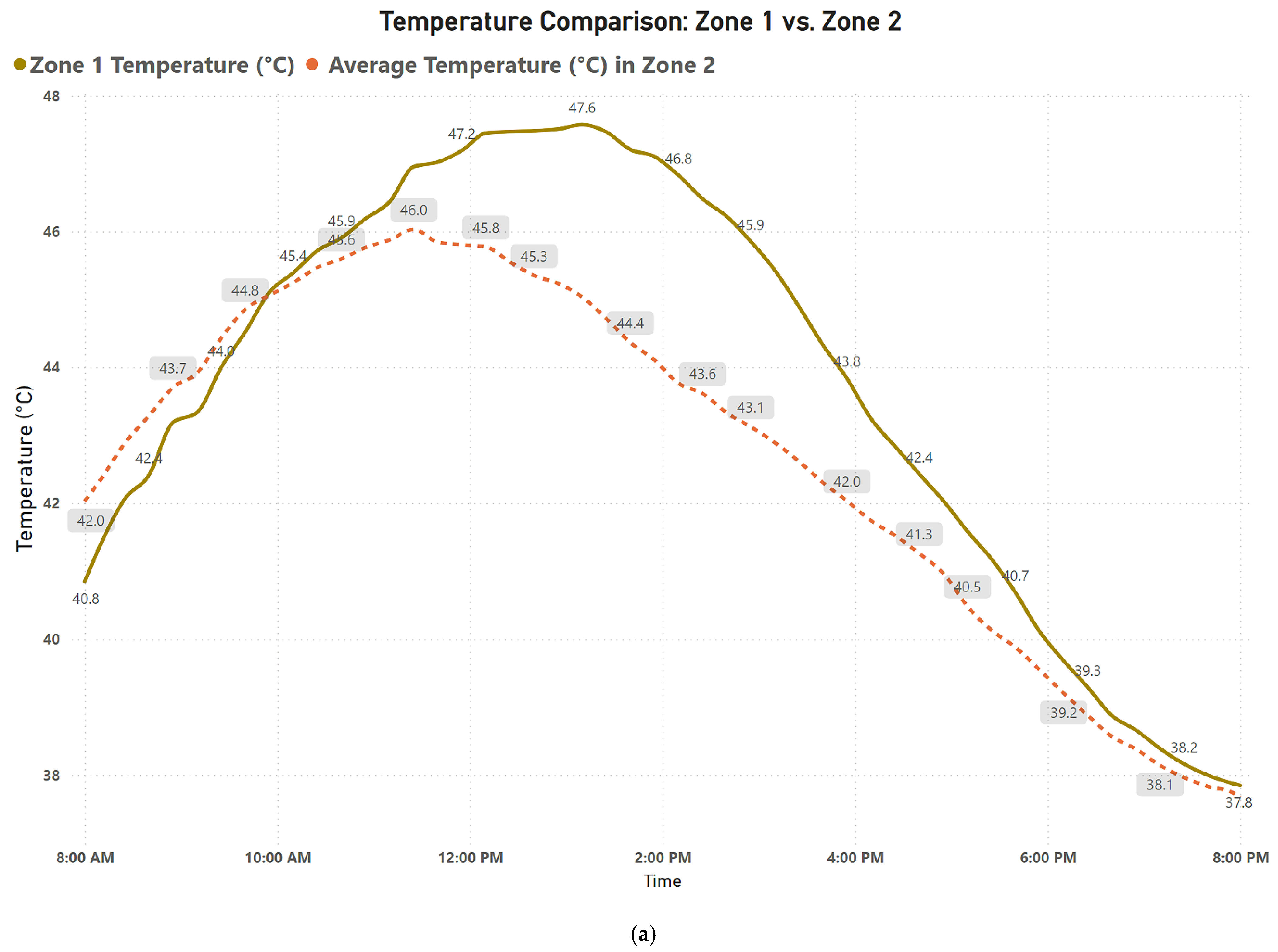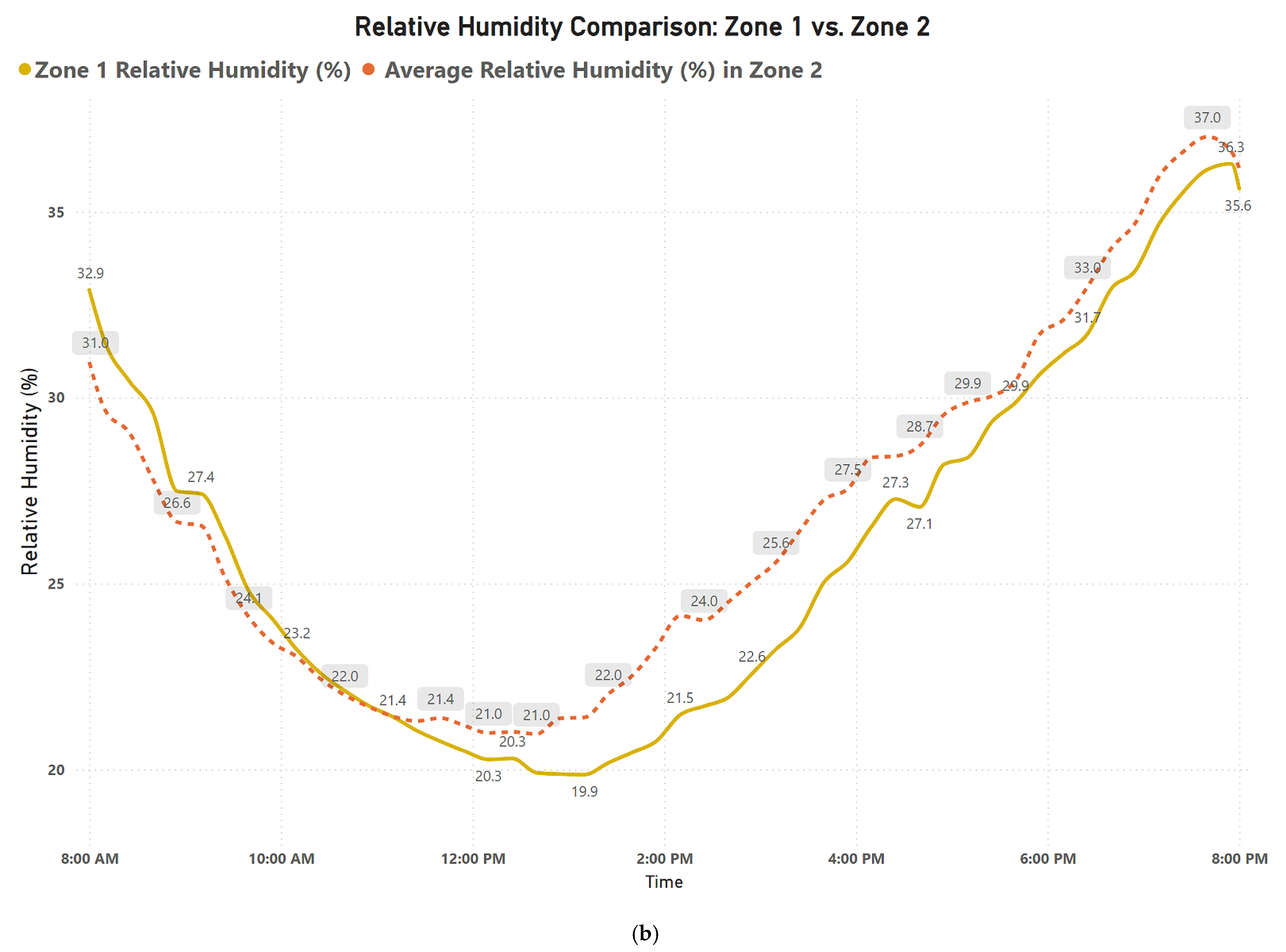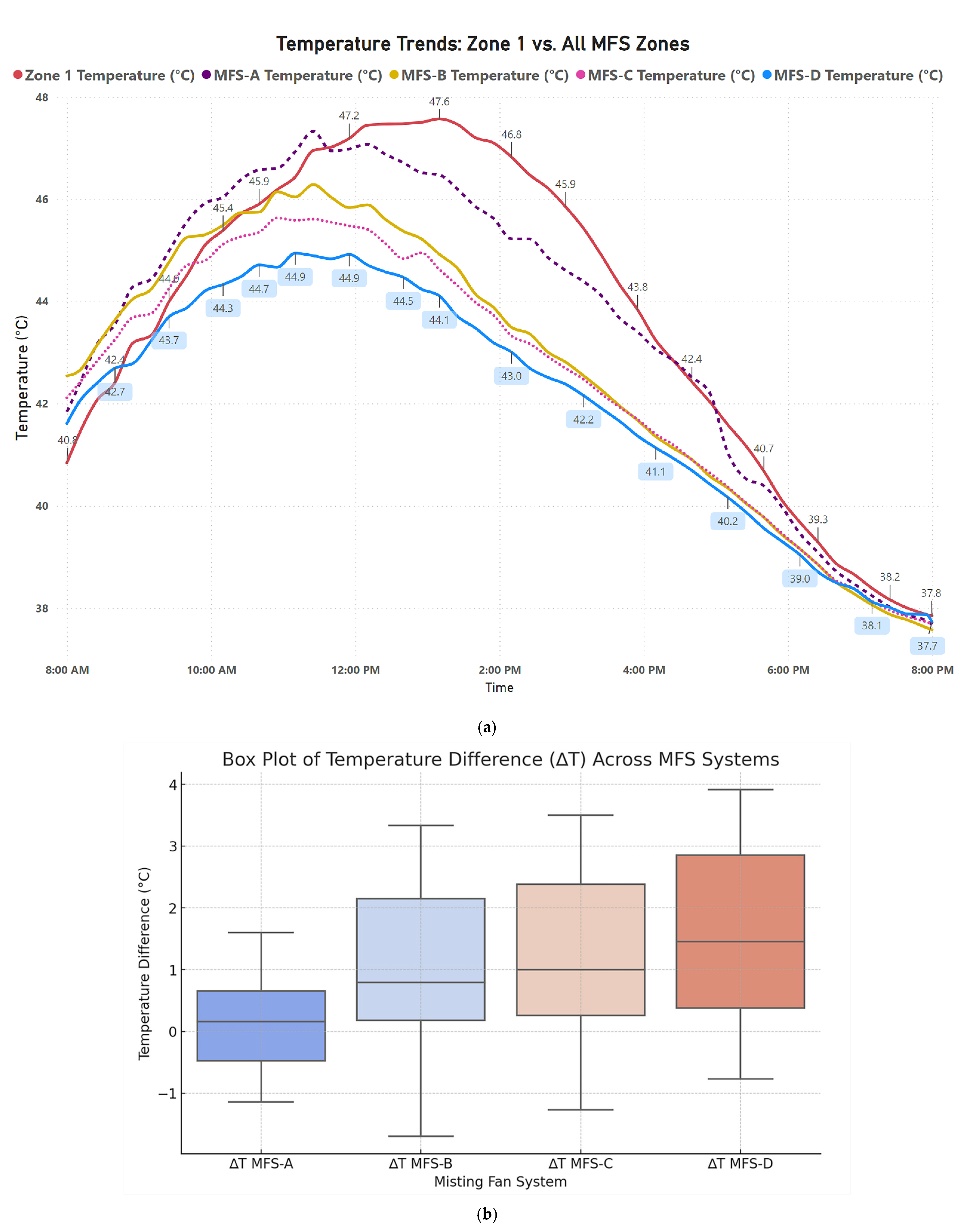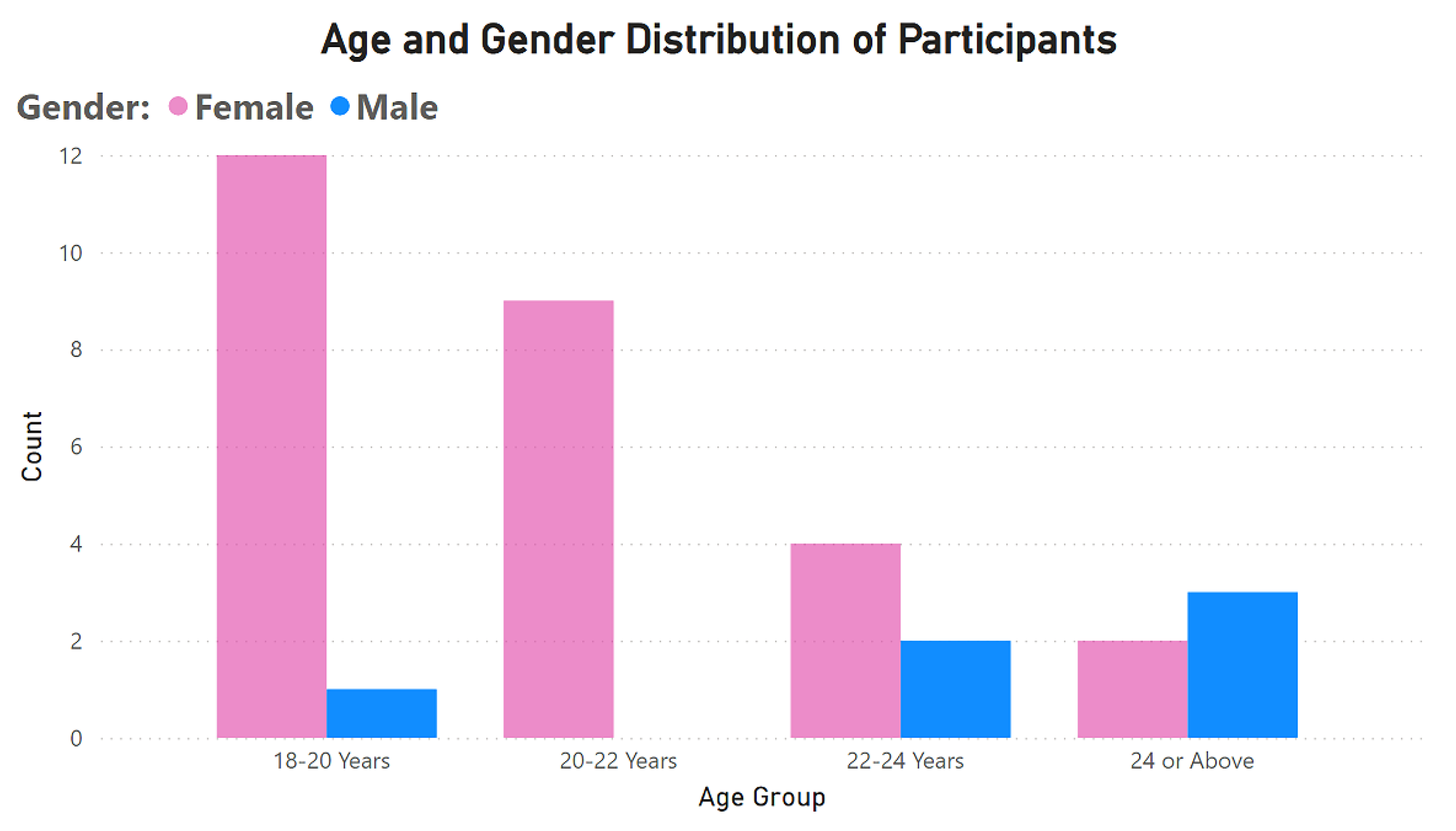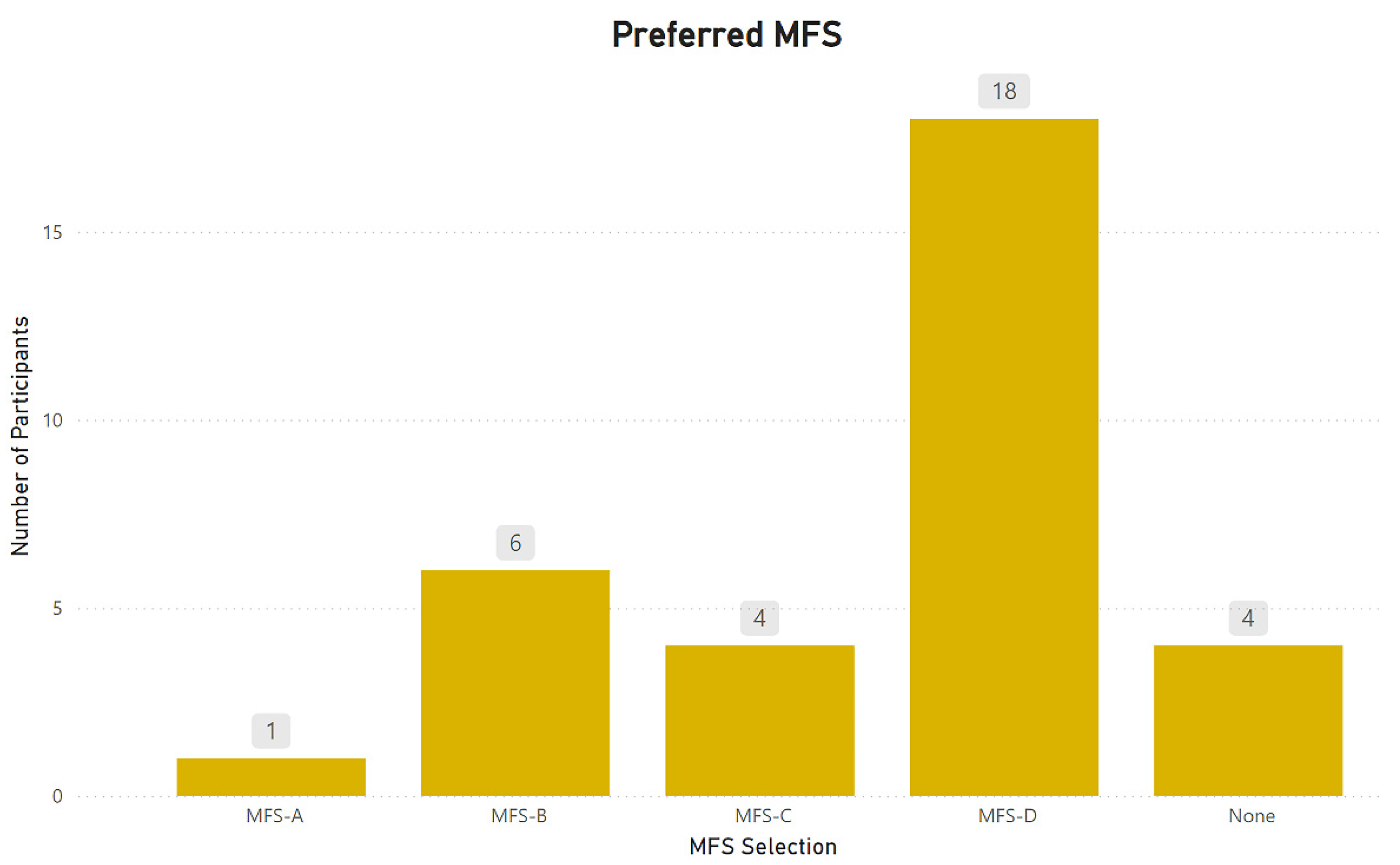1. Introduction
The Earth’s climate has shifted dramatically over time, with the arid and semi-arid regions of the Middle East and Northern Africa (MENA) experiencing the most significant changes [
1]. The vulnerability of cities in the MENA region to the effects of climate change, such as rising temperatures, water scarcity, and extreme weather events, is frequently highlighted in studies [
2,
3]. Research has focused on the urban heat island phenomenon in cities like Dubai, Abu Dhabi, Qatar, and Bahrain emphasizing the role of urbanization, land use change, and heat mitigation strategies [
4,
5]. Apart from that urban areas experience significant heat island effects exacerbated by factors such as lack of green spaces, extensive use of concrete and asphalt, and high energy consumption [
6,
7]. They are likely to persist in a warming climate, and rapid population growth will aggravate the negative effects of increased anthropogenic emissions on society [
8]. If current trends continue, temperatures could rise to nearly 50 °C by the end of the century [
9]. The above literature indicates that climate change will raise air temperatures in the Middle East to levels that are intolerable to the human body and societal well-being.
Bahrain, an island country with a semi-arid, humid subtropical climate in the MENA region, had a seasonal average maximum temperature of 40 °C in summer and an average minimum temperature of 14 °C in winter over the period from 1991 to 2020 [
10]. Bahrain has one of the highest per capita CO
2 emissions in the world and an energy-intensive economy. Several initiatives have been launched to lower CO
2 emissions, mostly through mitigation techniques by stakeholders in the public and private sectors [
11]. A study [
12] conducted highlighted the importance of implementing large-scale grid-connected photovoltaic (PV) system in Bahrain. The integration of a PV system into any demanding project in Bahrain is recommended to reduce power generation costs and diversify electrical energy sources. Moreover, there is considerable concern about how temperature changes affect Bahrain’s human health. Notably, compared to respiratory mortality, cardiovascular mortality increases significantly more during heat waves [
13]. In this way, evaporative and immersion cooling are the recommended immediate treatments for heat stress. Evaporative cooling involves spraying a mist of cool water (15 °C) on the patient’s skin and fanning warm air (45 °C) over the body [
14]. However, it is recommended to cool patients outside the hospital using any available means [
15].
Combining with PV systems, water mist systems have emerged as a highly potential solution for the immediate treatment of heat stress, particularly in the hot and arid climates of the MENA region, where passive cooling technologies often fall short [
16,
17]. Unlike shading systems, cool roofs, and green infrastructure, water mist systems utilize high-pressure water injectors to pulverize water into fine droplets of just a few tens of microns, allowing for rapid and efficient cooling of specific areas [
18]. The finely atomized water droplets quickly evaporate, creating a cooling effect that significantly reduces the surrounding air temperature, thus providing immediate relief from heat stress. A study comparing various thermal environment improvement methods across hundreds of projects worldwide highlighted the superior cooling effects of spray-based evaporative cooling [
19]. Another study demonstrated that these systems could reduce skin temperature by 1–3 °C within just 10 s, which is crucial for alleviating thermal stress [
20]. Beyond immediate cooling, water misting systems enhance outdoor environmental quality by suppressing heat and consuming modest amounts of water without the need for custom-fit hydraulic systems. They are non-toxic, expel dust and pollutants, attenuate harmful solar radiation, and repel insects like mosquitoes and flies [
21,
22]. Moreover, water nebulization is recognized not only as a preventive measure against heat stress but also as an emergency treatment for heat stroke [
16]. In this way, water mist systems have a high potential for providing immediate relief from heat stress in areas such as Bahrain. However, the design of water mist systems must be adapted to the specific needs and contextual conditions of the MENA region, ensuring they effectively address the physiological responses and thermal interactions between the environment and the human body.
To be more specific, these systems are flexible and effective in reducing extreme temperatures by lowering air temperature (T
a) and increasing relative humidity (RH). Atieh and Al Shariff [
23] demonstrated that solar-powered misting systems could cool the air by 10 °C in a sub-tropical desert climate, with a maximum RH gain of about 25%. Additionally, Huang et al. [
24] developed a quantitative model that showed mist spray systems could reduce T
a by 5–7 °C in hot environments, particularly when conditions are hot, dry, and wind still (T
a > 30 °C and RH < 70%). Considering the thermal perception of the human body, one study [
21] found that 83% of participants felt uncomfortably hot outside the spraying area between 12:00 PM and 14:00 PM, and this percentage dropped to 4% upon entering the mist. Another study [
25] compared subjects’ thermal perceptions before and after spending 2–10 min in the mist, demonstrating a reduction of 2–3 in thermal sensation in hot and humid extreme regions. Zhang [
26] found that after 10 min in the mist on typical hot summer days in Qingdao, China, subjects’ thermal sensation decreased from between hot and slightly hot (+1.44) to near to neutral (+0.33), and thermal comfort increased from almost slightly uncomfortable (−1.13) to near to slightly comfortable (+0.76).
In fact, mist systems’ performance and human comfort are significantly affected by various environmental factors beyond T
a, such as humidity, radiation, and air velocity. For instance, while Huang et al. [
27] concluded that the cooling efficiency of spray systems is better represented in dry and hot environments, Desert et al. [
25] found that these systems also perform well in hot and humid conditions without significantly increasing ambient humidity. Higher T
a and lower RH accelerate droplet evaporation, suggesting that the initial environmental conditions significantly influence spray cooling efficiency [
28,
29]. Huang et al. [
24] indicated that local humidity had a more significant cooling effect than temperature, achieving a cooling efficiency of 65% and reducing T
a by 5–7 °C at around 35 °C and 45% RH, while maintaining RH below 70%. Moreover, solar radiation is another critical factor, as it can accelerate water evaporation. Ulpiani [
21,
30] found that the intensity of solar radiation was negatively correlated with the drop in temperature during spray experiments, with 80% of subjects feeling pleasant warmth in the mist, indicating its suitability for highly irradiated regions. Oh et al. [
31] reported that high evaporation intensity occurs when temperatures exceed 27 °C under strong solar radiation. Furthermore, wind or fan speed influences spray cooling efficiency by enhancing water evaporation but can displace droplets, reducing cooling effectiveness [
24,
32]. However, studies usually focus on calm or breezy conditions due to the difficulty of controlling wind speed during operations. Ulpiani [
33] concluded that spray cooling effects were more apparent and measurable in still air conditions. Another study [
34] simulated fine water mist in an outdoor setting mimicking a hot summer urban environment with variable wind patterns, finding that temperature drops reached 6.7 °C experimentally, while numerical simulations suggested reductions of over 10 °C in downwind conditions. Therefore, it is crucial to consider the actual context, such as the specific climatic and environmental conditions of regions like MENA, to understand the performance and optimize the effectiveness of water mist systems.
Furthermore, equipment setup is critical for optimizing efficiency, as water pressure, droplet size, and nozzle height all have a significant impact on cooling performance and outdoor thermal comfort [
21,
24,
28]. Nozzle height and density are significant as they affect the cooling range and the wetting effects on pedestrians and roads [
35,
36]. Adjusting nozzle density by altering the number of nozzles and modifying nozzle height to control the distance from the user can fine-tune the system’s effectiveness. Studies [
37,
38] have demonstrated that higher pressure combined with smaller nozzles enhances cooling. Montazeri et al. [
39] examined the effects of varying water flow rates and nozzle heights, finding that both factors significantly influence performance. The optimal water pressure for high-pressure spraying is from 2 MPa to 7 MPa, with a spray volume between 20 mL/min and 50 mL/min [
27,
40,
41,
42]. Additionally, Farnham et al. [
36] found that nozzle diameter had a direct correlation with RH levels, though RH increased had a minimal effect on thermal comfort. Smaller droplet diameters are essential, as finer droplets remain airborne longer due to frictional forces, enhancing evaporation rates and cooling efficiency [
43,
44]. Fine droplets also better attenuate radiation, providing additional protection from harmful UV rays [
22]. Moreover, Zhou et al. [
45] highlighted that the gravity angle of nozzles affects heat transfer efficiency, with 30° or 120° being the most effective, and 180° being the least effective. Although these findings were often obtained under ideal conditions, they offer valuable insights for improving mist spray system operations and constructing effective setups. However, there is potential for further research exploration of these setups in actual contexts, especially in the MENA region, to understand the role of these and other factors like water temperature.
In particular, only one study has explored the effect of water temperatures on water mist performance. Zheng et al. [
46] evaluated the cooling effect of a double-flow pneumatics spray nozzle installed in a climatic chamber to simulate different climates, ranging from temperate (Tokyo-inspired) to tropical (Singapore-inspired). The system used 7–9 µm water droplets with a nominal volume flow rate of about 1 L/h at a pressure of 3 bar. Tests were carried out with various combinations of wet bulb depression, pressure, and water temperature. The study found that the system could effectively cool even in high-T
a and -RH conditions, with the optimal spray cooling efficiency observed at a water pressure of 0.35 Mpa. The results indicated that water temperature had no significant impact on the cooling performance. Moreover, this result has been cited as justification for holding water temperature constant in simulation optimization cooling studies [
47]. This finding, while informative, raises questions about its applicability in diverse outdoor environments. Applying these results to outdoor settings is challenging due to the controlled conditions of the climate chamber. Hence, there is a clear need for further research to understand the impact of water temperatures on water mist performance in real-world settings, particularly in the MENA region.
Therefore, this study aims to bridge the gap in existing research by focusing on the role of water temperature in enhancing the performance and effectiveness of water mist systems for rapid cooling. While the benefits of water misting for immediate heat stress mitigation are well documented, there is a lack of comprehensive studies on how varying water temperatures, such as ice water and other options, can further improve these systems. This research will explore the effects of different water temperatures on cooling efficiency and user thermal comfort. Research involving user samples will help to determine how temperature variations in water sprays might efficiently reduce heat and increase user comfort in outdoor surroundings. The study intends to provide empirical evidence on optimal water temperatures for misting systems, demonstrating how such modifications can improve their utility under hot, arid climates like in Bahrain and similar climates in the MENA region. The findings are expected to offer valuable insights into implementing more effective water mist cooling solutions in the MENA region, contributing to better heat stress management and overall environmental quality.
2. Materials and Methods
2.1. Research Methodology Workflow
This study employed a multi-method approach comprising three interrelated phases. First, a comprehensive literature review of over 50 articles and technical reports was conducted to identify research gaps, particularly regarding the influence of water temperature on mist spray systems, and to validate the experimental design and selected variables. Second, an experimental investigation was carried out through a comparative analysis of T
a and RH between two zones: a neutral zone (Zone 1) without cooling intervention, and a controlled zone (Zone 2) equipped with an automated mist fan system (MFS) programmed to enhance thermal comfort. This phase aimed to assess the real-world performance of the MFS under extreme climatic conditions. Finally, a participant-based survey was conducted in both zones to capture subjective thermal comfort responses and evaluate the system’s effectiveness from the users’ perspective. The integrated methodology is illustrated in the research workflow diagram (
Figure 1).
2.2. Study Site
This study was conducted in a semi-outdoor pedestrian passage on the campus of Kingdom University in Bahrain (26°8′9″ N, 50°35′1″ E). Bahrain, located on the southwestern coast of the Gulf region, has a semi-arid, humid subtropical climate classified as BWh (tropical and subtropical desert) under the Köppen system [
48]. The region experiences hot, humid summers and mild winters. Average annual temperatures are around 25 °C, with summer highs frequently exceeding 40 °C from June to September and winter lows ranging between 14 °C and 20 °C [
49]. High RH, especially in summer, ranges between 70% and 80%, intensifying the heat [
7]. The island’s monthly average humidity hovers around 65%, peaking at 88% in January and dipping to 39% in June. Predominantly northeasterly winds blow at speeds of 4.1–5.1 m/s throughout the year. In addition, Bahrain receives about 5.18 kWh/m
2 of solar radiation daily and enjoys 9.2 h of sunshine per day on average. This harsh climate, with over six months of oppressive heat and humidity, often confines residents to air-conditioned interiors, accounting for more than 70% of household electricity use [
50]. Taken together, these factors make Bahrain an ideal setting for investigating the effectiveness of mist spray systems, as its extreme heat and humidity pose significant challenges for cooling and energy management.
2.3. Experimental Setup
In this study, the experiment was conducted in a semi-outdoor pedestrian passage on the campus of Kingdom University, measuring 3.1 m in width and 38 m in length (see
Figure 2). A fabric tent covered the passage, providing partial shading while still allowing exposure to ambient outdoor conditions. On one side, a 1.6 m-high wall bounded the area, while open spaces and single-story buildings flanked the other side, creating a controlled yet semi-enclosed setting suitable for the experiment.
The passage was divided into two main zones. Zone 1, located at the northern end, spanned the initial portion of the passage and included a sensor (S01) to monitor environmental parameters—specifically Ta and relative RH—without any active cooling, considered as a neutral zone. Zone 2 covered the remaining length of the passage and featured four MFSs: MFS-A, MFS-B, MFS-C, and MFS-D. Each system operated under different parameters to evaluate performance and identify the most comfortable configuration. The rotation mode of the MFSs was fixed to ensure that the airflow from all fans remained parallel. This configuration was established to prevent any single fan from affecting the surrounding area.
Prior to the installation of the MSFs, the authors calibrated all four fans to ensure uniform wind speed and consistent water consumption in the mist. All mist fans were equipped with a full tank of water and operated for one hour in a room with stable climatic conditions. The wind speed was measured in front of each fan at a constant distance from the center of the fan blades. After one hour, all fans were turned off, and the water consumption from each mist fan tank was recorded. No significant differences in wind speed or water consumption were observed among the mist fan systems.
Every MFS was installed at a height of 1.425 m (no rotation) and equipped with 192 nozzles. These nozzles had a diameter of 0.3 mm, a discharge radius of 0.15 mm, an average droplet size of 4.34 µm, and a flow rate of 0.05 L/min. Moreover, each MFS was monitored by a dedicated sensor (S02, S03, S04, and S05) for real-time T
a and RH readings, which informed the programming and control of the mist fans. The sensors (Sensor Push brand) followed the specifications detailed in
Table 1.
To minimize reliance on the power grid and address Bahrain’s high electricity demand in a sustainable way, a 2.4 kWh PV system was installed to power the water mist system during daytime. Each MFS, operating at a maximum capacity of 300 watts, was equipped with Event Stream Processing (ESP) units and 4-relay modules. ESP is a software-based technique that processes continuous streams of device data in real time, enabling dynamic control of fan speeds and water pumps based on actual T
a and RH readings. These readings were obtained via Bluetooth from SensorPush devices placed near each mist fan (see
Figure 3).
The control system functions by sending periodic data requests from the ESP to the SensorPush device. In response, the sensor transmitted current environmental data back to the ESP, which analyzed them according to nine pre-defined conditions. Based on these conditions, the ESP sent commands to the 4-channel relay module, regulating fan speeds and mist output. This entire cycle repeated every 10 s, ensuring efficient energy use and maintaining a comfortable thermal environment. The ESP units were programmed to automate mist operation, with the goal of keeping the area within the human thermal comfort zone while minimizing unnecessary energy consumption.
2.4. The Selection of Indicators of Thermal Performance
Because comfort standards vary widely, the authors examined multiple factors from the existing literature to define suitable comfort zones for users. They drew on guidelines from the American Society of Heating, Refrigerating, and Air-Conditioning Engineers (ASHRAE), which recommends temperature ranges from 20 °C to 26.67 °C and RH levels between 30% and 60%. Additional studies have suggested that human thermal comfort generally falls between 22 °C and 27 °C, with RH between 40% and 60%. In light of these variations, the authors adopted a specific comfort range based on ASHRAE 55 [
51] and ISO 7730:2005 (PMV) [
52] guidelines [
53]. Using psychrometric charts, they determined that thermal comfort in this study corresponded to T
a between 22.4 °C and 30.4 °C, with RH ranging from 30% to 80% (
Figure 4 and
Table 2). These parameters informed the programming of the ESP controllers in the MFSs, enabling each subzone to maintain conditions within the target comfort range.
Figure 4 depicts the thermal comfort ranges and their eight adjacent ranges, illustrating how the system adjusts T
a and RH accordingly.
A system was designed to regulate environmental conditions by adjusting the fan speed and mist activation based on the measured RH and Ta. Specifically, the system operated in different modes depending on whether the RH and Ta fell within pre-defined comfort ranges: fan speed two with active mist for non-comfort range 1, fan speed three with inactive mist for non-comfort range 2, fan speed one with active mist for non-comfort range 3, fan off with inactive mist for non-comfort range 4, fan speed one with inactive mist for non-comfort range 5, fan speed three with active mist for non-comfort range 6, fan speed three with inactive mist for non-comfort range 7, and fan speed three with active mist for non-comfort range 8. When RH and Ta were within the target comfort ranges, both the fan and mist were deactivated. In this setup, the mist system was consistently operated using room temperature water maintained within a range of 22–25 °C.
To evaluate the effectiveness of the MFSs in transitioning from non-comfort to comfort conditions, a longitudinal study was conducted from 30 October 2023 to 16 July 2024. Environmental data were collected via SensorPush devices installed in both the neutral zone (Zone 1) and the misted zone (Zone 2), resulting in a total of 24,954 logged readings. These readings were processed using Microsoft Excel to assess the frequency with which Ta and RH fell within the defined comfort boundaries. The analysis applied the following conditional formulas:
Zone 1 Comfort Range=IF(AND(Ta1 >= (−0.044*RH1 + 25.92), Ta1 <= (−0.058*RH1 + 32.1), RH1 >= 30, RH1 <= 80), TRUE, FALSE)
where Ta1 and RH1 represent the air temperature and relative humidity recorded by the SensorPush device in Zone 1.
Zone 2 Comfort Range=IF(AND(Ta2 >= (−0.044*RH2 + 25.92), Ta2 <= (−0.058*RH2 + 32.1), RH2 >= 30, RH2 <= 80), TRUE, FALSE)
where Ta2 and RH2 represent the average air temperature and relative humidity in Zone 2.
Change from Non-Comfort to Comfort=IF(AND(Zone1_Comfort = FALSE, Zone2_Comfort = TRUE), TRUE, FALSE)
Total Transitions Counted Using=COUNTIF(Transition_Range, TRUE)
This analysis allowed the research team to quantify the number of instances where the mist fan system successfully shifted the environmental conditions from non-comfort to comfort, offering insight into its overall performance and efficiency.
Moreover, experimental conditions were adjusted to investigate the influence of water temperature on the MFSs’ performance. First, the research team varied the amount of ice in the water tanks of the four MFSs, then monitored the resulting temperatures via thermometer (S02–S05).
Table 3 presents the water temperatures measured for each MFS (in °C). Next, two fan-speed modes were tested across the MFSs—speeds of 3, 3, 2, and 3 for MFS-A, MFS-B, MFS-C, and MFS-D, respectively—while an anemometer recorded an average air velocity of about 2 m/s for all systems.
2.5. Participant Selection and Experiment Condition
To assess the MFSs and survey scenario, the authors conducted a mock scenario one day before the survey, adopting the roles of participants. They observed the thermal comfort conditions by spending 5 min in Zone 2 in front of the MFS and 10 min in the neutral zone, accounting for the time taken to transition between Zone 1 and Zone 2. Thus, the authors were firmly convinced of the appropriate time to predict changes in comfort status. The study participants were selected through random sampling, focusing on students from Kingdom University, and the authors conveyed the research project objectives to the students. The authors employed two methodologies to verify the sample size of 33 respondents to the survey of the participants: benchmarking, which was based on prior research, and the statistical method.
In total, 33 students took part, of whom 82% were female and 18% male, with ages ranging from 18 to 26 years (mean age: 22). The thermal comfort survey conducted by the scholar referenced in [
25] and [
54] utilized 20 and 16 participants, respectively, to assess thermal comfort conditions. In their investigations into indoor thermal comfort, studies [
55,
56,
57] have utilized a priori sample size analysis to ensure the robustness and reliability of their findings. This method necessitates the determination of the required number of participants before data collection commences. Notably, these studies opted for sample sizes of fewer than 20 individuals. For the selected sample size, the Margin of Error (MoE) was calculated using the following formula [
58].
where:
Z = Z-Score, equal to 1.96 for 95% of confidence;
p = estimated proportion of confidence (0.5 is used for most conservative cases);
n = sample size.
Based on the validation provided above, and due to limited MFS zone capacity and the need for consistent climate conditions, a survey of 33 participants was conducted in a limited timeframe. To ensure participant comprehension and accuracy, a pre-survey induction explained the study’s requirements, time allocation for each group, and questionnaire distribution.
To evaluate the impact of MFSs on student thermal comfort during peak summer heat, an experiment was conducted on 26 June 2024, between 3:00 and 4:30 PM. The study utilized two zones: a neutral zone (Zone 1) and an MFS zone (Zone 2), which included MFS-A, MFS-B, MFS-C, and MFS-D. Students were divided into five groups, each following a specific schedule to ensure thorough exposure to the MFSs. Participants spent 10 min in the neutral zone before moving sequentially through each MFS area. This initial period in the neutral zone aimed to allow participants to return to a baseline thermal comfort state, minimizing the carryover effect from previous MFS exposures. The division into five groups was necessary due to space constraints, as each MFS area could comfortably accommodate a maximum of seven people, while the neutral zone could accommodate up to fourteen. The time management of the survey, including the group schedules, is detailed in
Table 4, which presents all times as PM.
Finally, a questionnaire was administered to evaluate how the varying water temperatures and fan speeds affected human thermal comfort. The questionnaire was prepared in English and divided into three parts to capture different dimensions of thermal comfort and environmental perception. Part 1 collected demographic information such as age, gender, clothing type, and color. Part 2 documented students’ thermal and humidity perceptions in Zone 1 using a seven-point scale adapted from ASHRAE standards [
51]. This scale assessed thermal perception (−3 cold, −2 cool, −1 slightly cool, 0 neutral, 1 slightly warm, 2 warm, and 3 hot) and humidity perception (−3 very dry, −2 dry, −1 slightly dry, 0 neutral, 1 slightly humid, 2 humid, 3 very humid). Part 3 extended these assessments to Zone 2 in comparison to Zone 1, where the MFSs operated under varying water temperatures, allowing the researchers to compare subjective comfort levels between the two zones.
In order to assess the respondents’ agreements, the authors used RStudio 2024.12.0 software to compute the Kendall’s coefficient and Chi-square value for three groups of data: the respondents’ feelings of Ta in Zone 1 (Neutral Zone) and Zone 2 (mist zone); the respondents’ feelings of RH in Zone 1 (Neutral Zone) and Zone 2 (mist zone); and the respondents’ comfort among the four MFSs. Then, the result was compared to the standards where the literature has interpreted of respondents’ agreements based on Kendall’s coefficient (W) as W = 0: no agreement among raters; W = 1: complete agreement among raters; 0.1 ≤ W < 0.3: weak agreement; 0.3 ≤ W < 0.5: moderate agreement; 0.7 ≥ W ≥ 0.5: strong agreement, W > 0.7: very strong agreement [
59,
60,
61]. Kendall’s coefficient of concordance (W) was computed as follows:
The formula for calculating Chi-square
is:
where:
;
;
;
;
;
= mean of .
Critical Chi-square values at a 95% confidence level were derived from standard statistical tables: 3.84 for datasets involving two comparative conditions (Subjects 1 and 2), and 7.81 for the dataset involving four comparative conditions (Subject 3) [
62].
4. Discussion
As highlighted in recent review papers [
33], misting systems are particularly advantageous in arid and warm climates, though they have also performed admirably in hot, humid, and temperate regions. Most experiments were conducted during the summer or mild winter seasons, where optimal thermohydrometric conditions typically ranged from 70% relative humidity to 30–35 °C ambient temperature. In contrast, our current study was conducted under extreme summer conditions in a hot, arid, and humid climate, with thermohydrometric conditions averaging 20–65% humidity and daytime temperatures reaching 35–45 °C.
4.1. The Effectiveness of the Mist Fan System
Experimental studies have indicated that misting systems can achieve local temperature reductions ranging from 1–2 °C to over 15 °C [
33]. The average temperature drop is typically 7–8 °C, with variations attributed to factors like nozzle design, operating pressure, system layout, misting duration, local microclimate, and the type of cooled area (open outdoor, semi-enclosed, or indoor). Notably, only a single study [
46] examined the impact of water temperature on misting systems using room temperature water. The study found a minimal temperature reduction of approximately 0.1 °C across water temperatures ranging from 18.5 °C to 29 °C. In contrast, our current experiment explored the use of significantly lower water temperatures, ranging from 19.3 °C to 7.7 °C, representing slightly chilled to cold water conditions, integrated into a mist fan system. The study generally operated within thermohydrometric boundaries of 20–70% relative humidity and 30–35 °C ambient temperature. In contrast, our current study observed a 2–4 °C temperature reduction within the MFS zone compared to the non-MFS zone, specifically in a semi-outdoor setting during peak summer temperatures of 40–45 °C.
According to the current experimental results, the RH frequently fell below 30% during daytime summer hours, putting the subject outside of the desired comfort range. However, the MFSs kept RH levels 5–10% higher than ambient, demonstrating the moistening effect of mist evaporation. While the MFS may not have a significant impact on overall environmental conditions, they do immediately reduce heat stress by moderating peak temperatures and maintaining humidity levels closer to the comfort range. These findings highlight the potential of MFS as a heat mitigation strategy in extreme climates, particularly in urban areas where direct sunlight and high temperatures exacerbate thermal discomfort.
4.2. The Effectiveness of the Water Temperature on the Outdoor Thermal Environment
The evaluation of water temperature and fan speed in MFS performance highlights the significant role of cooler misting temperatures and optimized airflow in improving outdoor thermal comfort. The findings confirm that lower water temperatures, particularly in MFS-D (7.7 °C), resulted in the most substantial temperature reductions, with an average cooling effect of up to 4 °C compared to Zone 1. Conversely, higher water temperatures, such as in MFS-A (19.3 °C), had the least cooling impact, emphasizing the importance of utilizing colder water for effective mist cooling in extreme heat conditions. Similarly, the ∆RH analysis underscores that misting systems counteract excessive dryness, with MFS-B and MFS-C achieving the highest RH gains, peaking at 3.53% and 3.20%, respectively. However, while higher fan speeds (MFS-B) improved air circulation, they also reduced mist persistence, limiting full evaporative potential. In contrast, the MFS-C’s fan speed allowed for longer mist suspension, leading to greater RH retention and improved cooling stability. This balance between fan speed, evaporation rate, and water temperature suggests that mist cooling efficiency can be maximized through a carefully controlled combination of lower water temperatures and optimized air velocity. In this way, these findings reinforce that water temperature is the primary determinant of cooling effectiveness, while fan speed plays a crucial role in regulating mist dispersion and moisture retention.
The study’s findings showed a smaller impact than those of earlier studies [
33], which was caused by the intense summer weather that persisted during the investigation. The findings also indicate that, in severe conditions like those in Bahrain and the broader MENA region, lowering the water temperature further is essential for optimal cooling. However, the mist spray systems demonstrated certain limitations in achieving the desired thermal comfort conditions across all MFSs in Bahrain’s extreme conditions. In fact, the average T
a across the experimental zones remained significantly above the upper comfort limits during the midday hours, particularly between 10 AM and 4 PM, when the influence of solar radiation was most intense. Despite the operation of mist systems, which effectively reduced temperatures by close to 4 degrees in MFS-D, the cooling effect was insufficient to bring the temperatures consistently within the desired thermal comfort range during this peak period. The inability of the mist systems to provide sufficient cooling under these extreme conditions may be linked to the limitations of evaporative cooling mechanisms, which are less effective when RH levels are high, which is characteristic of Bahrain’s summer climate. With average RH levels oscillating between 20% and 40% during the experimental period, the latent cooling effect achieved by water mist sprays was mitigated, reducing the system’s overall effectiveness.
4.3. The Effect of the MFS on User Comfort
The findings from the survey results suggest that mist cooling enhanced thermal comfort by reducing “Hot” and “Slightly Warm” perceptions while maintaining humidity within an optimal range. The observed improvements in thermal comfort—particularly the dramatic reduction in “Hot” perceptions—echo the findings of other investigations into mist-based cooling. A study [
25] reported that just a few minutes of mist exposure in hot, humid environments can lower thermal sensation levels by 2–3 points, mirroring the shifts seen in our participants. Similarly, another study [
26] demonstrated that 10 min in a mist-cooled space could bring individuals’ thermal sensation close to neutral and boost comfort ratings from slightly uncomfortable to slightly comfortable. These congruent outcomes reinforce our results, underscoring the consistency of mist cooling’s positive impact on subjective thermal experience. Moreover, the strong preference for MFS-D may stem from its ability to cool effectively without significantly raising humidity levels. In hot climates, higher temperatures and lower RH can speed up the evaporation of mist droplets [
28,
29], preventing the air from becoming muggy. Since MFS-D used the lowest water temperature and showed lower RH compared to MFS-B and MFS-C, it provided a refreshing sensation while also taking advantage of the rapid evaporation rate. The survey recorded the comfort of occupants within different MFS settings. The exploration of the cooling effect in space demonstrates that mist creates a gradient of conditions, rather than a homogeneous environment, allowing occupants to elect their level of comfort and experience thus curating a variety of atmospheres. Hence, the result supports the effectiveness of mist cooling in creating a more thermally neutral outdoor environment, helping individuals experience relief from heat without excessive humidity buildup. This balance is particularly important in hot and arid climates, where heat stress and dehydration risks are high, and mist cooling provides a viable solution for mitigating extreme conditions while maintaining comfort.
Moreover, the Chi-square critical value is a crucial element in statistical hypothesis testing, particularly in scenarios involving categorical data. When comparing two related subjects, such as temperature in two distinct zones or relative humidity in those same zones, a Chi-square critical value of 3.84 at a 95% confidence level indicates the threshold for statistical significance with one degree of freedom. This value is used to determine if observed differences between the two zones are likely to be due to chance or represent a genuine relationship. Conversely, when examining comfort ratings across multiple areas (MFSs), the complexity increases, leading to a higher critical value of 7.81. This elevated value reflects the increased degrees of freedom associated with analyzing more categories or variables. The Chi-square distribution, with its critical value tables, plays a vital role in both goodness-of-fit tests, assessing how well observed data align with expected distributions, and tests for independence, determining whether two categorical variables are related or independent.
4.4. The Effect of the Mist Fan Automated System
The MFSs demonstrated their on-demand utility, proving unnecessary for continuous operation due to fluctuating comfort levels throughout the day. To mitigate energy consumption associated with mist generation, fan operation, and water cooling, a solar-powered MFS is a viable solution. Furthermore, implementing an automated control system, responsive to ambient conditions, can optimize resource utilization by activating the MFS only when needed, thereby enhancing comfort while minimizing water and energy consumption and preventing excessive heat and humidity buildup.
The observed low transition efficiency of 2.9% appeared to be significantly influenced by extreme summer conditions, indicating the MFS’s limited ability to shift environmental conditions from non-comfort to comfort ranges. The finding suggests that the current system configuration is insufficient to counteract the high temperatures and humidity experienced during these periods. Consequently, further experimentation is crucial to optimize the system’s performance under such demanding circumstances. Specifically, investigations should focus on evaluating the impact of increased fan speeds and the utilization of chilled water to enhance the cooling capacity and facilitate a more effective transition toward comfortable environmental ranges.
6. Conclusions
The MENA region, including Bahrain, faces severe climate change impacts such as rising temperatures, water scarcity, and urban heat island effects, with projections indicating extreme heat conditions nearing 50 °C by the end of the century. Bahrain, with one of the highest per capita CO2 emissions, is adopting mitigation strategies, including large-scale PV systems to reduce energy costs and diversify power sources. To combat heat stress, evaporative cooling and water mist systems are increasingly recommended, with their integration into PV-powered infrastructure offering a promising solution for sustainable cooling in harsh environments. In this way, this study set out to investigate the influence of water temperature on the performance of water mist spray systems in Bahrain’s extreme climates, using a field experiment. The experimental results and participant surveys consistently demonstrated that lowering water temperature markedly enhances the cooling effectiveness of mist systems. In particular, MFS-D—operating with water at 7.7 °C—achieved up to a 4 °C reduction in ambient temperature relative to non-misted conditions during peak solar radiation hours, and it maintained higher, more stable relative humidity levels that helped counteract the dryness experienced in the absence of mist cooling.
Subjective assessments from participants further corroborated the objective measurements. The introduction of mist cooling significantly shifted thermal perceptions away from discomfort; a majority of participants reported a transition from feeling “Hot” or “Slightly Warm” to “Natural” or even “Slightly Cool” upon exposure to mist. This positive feedback, alongside the environmental data, validates the potential of water mist systems as an immediate and effective heat stress mitigation strategy in hot, arid regions. Moreover, more than half of the participants (54.5%) identified MFS-D as their top choice, citing immediate relief from “hot” and “slightly warm” sensations. This alignment with objective measurements underscores that lowering water temperature can significantly enhance both measured cooling outcomes and perceived comfort in extreme heat. By contrast, the differences in MFS-B and MFS-C illuminate the delicate balance between water temperature and fan speed: MFS-B deployed a slightly cooler mist (12.3 °C) with a higher fan speed, which accelerated air movement but may have reduced the droplet “hang time” needed for thorough evaporation. Meanwhile, MFS-C used marginally warmer water (13.1 °C) at a lower fan speed, allowing droplets to linger and evaporate more gradually, thereby preserving RH more effectively. Objectively, MFS-C maintained marginally lower temperatures and higher humidity than MFS-B, but subjectively, more participants preferred MFS-B over MFS-C—suggesting that the sensation of stronger airflow can sometimes outweigh the benefits of slightly higher mist temperatures. Such nuances highlight that while cooler water is pivotal for optimal performance, a harmonious interplay between mist temperature, droplet residence time, and air circulation is essential to maximize both objective cooling metrics and subjective comfort.
The gathered data reveal a statistically significant and robust positive correlation among participants’ responses across multiple assessed variables. There was a significant concordance between reported Ta feelings in two separate zones, as well as a strong correlation in RH feelings within those same zones. Moreover, participant comfort levels across various MFS domains demonstrated significant consistency. The findings, supported by statistical significance testing, indicate that the observed correlations were unlikely to result from random chance. Thus, the authors considered the survey results to be reliable and representative, given the relatively small sample size. This consistency suggests that individuals generally evaluated the zones similarly, and that differences in perceived comfort within one zone may have forecasted perceptions in others. Consequently, the authors viewed the survey results as valid and reflective of the participants’ experiences.
Hence, the findings reveal that water temperature is a key factor in cooling efficiency for mist systems, with lower temperatures facilitating faster evaporation and enhanced thermal relief. However, the study also underscored the importance of balancing water temperature with fan speed. While higher fan speeds can improve air circulation, they may inadvertently reduce the residence time of mist droplets, limiting their evaporative potential. Thus, optimizing the interplay between water temperature and fan speed—evidenced by the performance differences between MFS-B and MFS-C—is crucial for maximizing cooling benefits.

